- Products
- ProspectSQL/MQL list building with high levels of personalization, real-time data enrichment and prospect search
- Email FinderFind individual or bulk emails by entering the person & company name or domain
- Email VerifierVerify emails addresses individually, in bulk or through API, with 99% accuracy
- Clearout For SheetsVerify email addresses directly on Google Sheets with Clearout for sheets add-on
- ClearoutPhoneValidate phone numbers across 240+ countries in bulk, quick or real time validation Free Tools
- Disposable Email Checker
- Reverse LinkedIn Profile Lookup Tool
- Reverse Email Lookup Tool
- Email List Cleaner
- Resource
- Pricing
- Integrations
- Enterprise
- Login
How To Create a Drip Email Campaign That Converts Leads
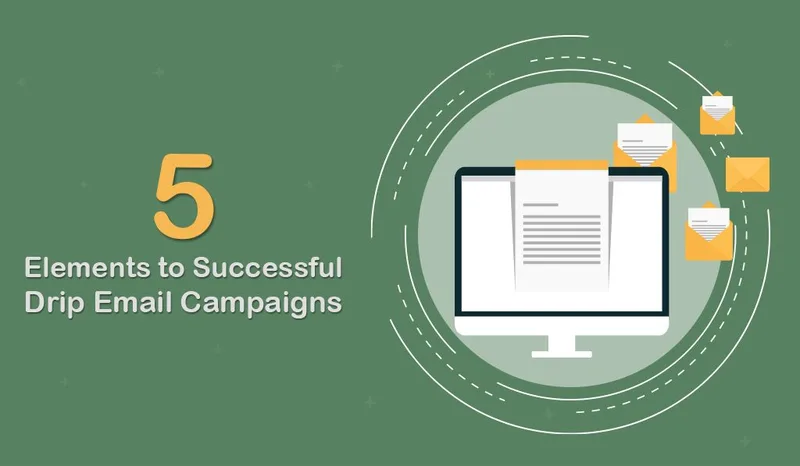
A single email won't drive your business sales, as one text won't convince your friend after a fight.
Automated email campaigns have proved to be a better choice to accomplish your business goals, for example:
Automated email campaigns have proved to be a better choice to accomplish your business goals, for example:
Martech Zone's study states that drip email campaigns' open rates are about 80% higher than that of a single email.
Unfortunately, we can't help you to convince your friend. But this article will help you to scale your business by amping up your B2C and B2B email marketing game with the help of drip email campaigns.
Unfortunately, we can't help you to convince your friend. But this article will help you to scale your business by amping up your B2C and B2B email marketing game with the help of drip email campaigns.
What is a drip email campaign?
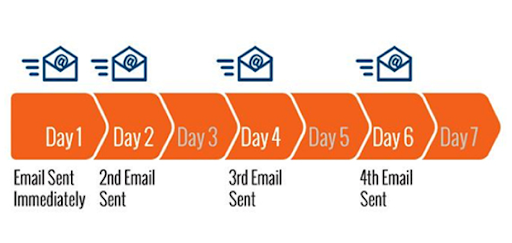
A drip email campaign is a marketing strategy that is used to send automated emails to the targeted audience at a specific time. In simple words, it is a strategy of sending emails to your audience after they have taken a specific action on your website.
Businesses use these campaigns to get in touch with their audience and keep them updated with their services.
For example, a visitor from your website fills out a form to get them registered for an online event. Once they click submit, a personalized automated email is sent to them.
But you don’t want to end the relationship with your visitor there. After the welcoming email, you’d introduce your business and send them another email regarding the event.
Even though these drip emails are automated, they can be personalized by using the visitor's name, contact information, and more.
Businesses use these campaigns to get in touch with their audience and keep them updated with their services.
For example, a visitor from your website fills out a form to get them registered for an online event. Once they click submit, a personalized automated email is sent to them.
But you don’t want to end the relationship with your visitor there. After the welcoming email, you’d introduce your business and send them another email regarding the event.
Even though these drip emails are automated, they can be personalized by using the visitor's name, contact information, and more.
How to create a drip email campaign?
Whether you want to increase sales, boost customer engagement, or generate leads, creating a drip email campaign is all you need.
Let me walk you through each step of developing a drip campaign.
Let me walk you through each step of developing a drip campaign.
STEP 1: Determine your campaign’s goal:

Having a clear understanding is an essential step for any marketing strategy. A drip email campaign is no different.
Your objectives may include the following -
Your objectives may include the following -
Based on your objective, you'll likewise need to decide the kind of drip email campaign you need to run. You have a bunch of choices, including:
- Welcome: Welcome campaigns ought to be utilized for each new contact or subscriber of your email list. Successful welcome drip email campaigns incorporate a little arrangement of emails that acquaint them with your products or services and sets the table for what they can hope to get from you.
- Webinars or online courses: Such drip campaigns send a confirmation message after someone signs up for a webinar, followed by several relevant messages that direct participants to the online course.
- Retargeting: This sort of drip campaign can truly be utilized for a variety of instances. You may run a retargeting campaign when a client forsakes their cart or signed up for a lead generation form yet made no move.
- Re-Engagement: Similar to a retargeting drip email campaign, an engagement campaign is utilized to endeavor to inspire and retain customers to make another buy. Keep in mind, it's 5 to multiple times increasingly costly to procure another client contrasted with keeping a present one.
STEP 2: Decide your target group
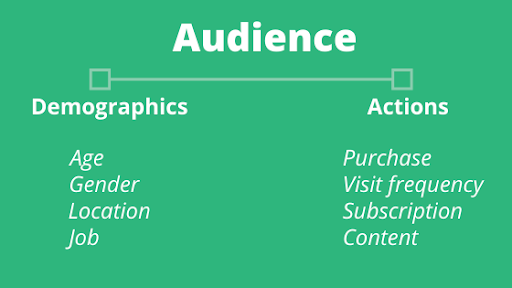
Drip email campaigns are about delivering the right message to your targeted audience. Even if you try hard, you can't reach everyone at once.
Therefore, a brand's marketing team first needs to address its target audience. Understand who it is you’re trying to reach, what they need, and how you can help them.
Then, you can decide what groups you want to target depending on your campaign goal.
Therefore, a brand's marketing team first needs to address its target audience. Understand who it is you’re trying to reach, what they need, and how you can help them.
Then, you can decide what groups you want to target depending on your campaign goal.
When you know the kind of email drip campaign you need to build, and which segment of your audience you need to send it to, you can build your own automated customer journeys.
Automated journeys are the workflows that your drip campaigns will pursue dependent on the moves your customers make.
Read>> Email Segmentation For Targeted Marketing & Better Conversion
Automated journeys are the workflows that your drip campaigns will pursue dependent on the moves your customers make.
Read>> Email Segmentation For Targeted Marketing & Better Conversion
STEP 3: Nail your emails with personalization
It's about them!
This cannot be stressed enough—people respond better to emails and content that is personalized to them.
Although your emails are automated, they don't have to sound robotic. Make your email personal so people don't feel like they are communicating with a robot. The humanized conversation with a personal touch is your key to building stronger relationships.
This can be done in a variety of different ways, including the simple name in the subject line that allows users the opportunity to select what types of emails they want to see in the future.
This cannot be stressed enough—people respond better to emails and content that is personalized to them.
Although your emails are automated, they don't have to sound robotic. Make your email personal so people don't feel like they are communicating with a robot. The humanized conversation with a personal touch is your key to building stronger relationships.
This can be done in a variety of different ways, including the simple name in the subject line that allows users the opportunity to select what types of emails they want to see in the future.
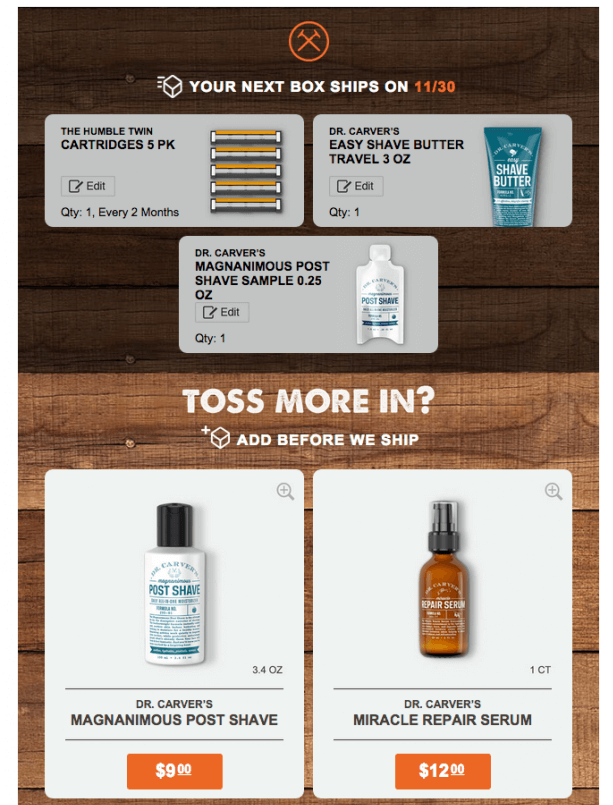
STEP 4: Set up a trigger
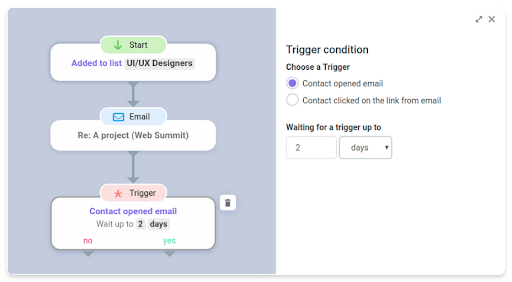
Setting up a trigger means setting up who will receive which kind of emails on what condition.
Your conditions can be:
Your conditions can be:
For example, in the event that you send an email with an invitation to take action requesting your audience to download an eBook and they finish that activity, at that point the subsequent stage in their voyage may be to get an automated email with extra information they may discover valuable dependent on the eBook.
In any case, in the event that they don't download the eBook, they'll move into an alternate journey where they may get another email seven days after the fact requesting that they download the eBook once more.
Computerized ventures are basic to guaranteeing your drip campaign has an increasingly customized touch, since they enable you to alter the messages your audience gets depending on where they are in your campaign.
In any case, in the event that they don't download the eBook, they'll move into an alternate journey where they may get another email seven days after the fact requesting that they download the eBook once more.
Computerized ventures are basic to guaranteeing your drip campaign has an increasingly customized touch, since they enable you to alter the messages your audience gets depending on where they are in your campaign.
STEP 5: Discover a rhythm that works for you
This is where things can get somewhat precarious on the grounds that there's actually no right or wrong answer. Depending on your audience, business, and objectives, you could have an alternate email rhythm for every one of your campaigns.
For instance, new supporting or welcome email drip campaigns could begin at around 6 emails over 30 days before moving to something that better lines up with explicit buyer’s journeys or decision-making moments.
Another alternative that likewise customizes emails for customers is to enable them to redo the recurrence at which they get emails.
It's dependent upon you to test and figure out what works best for your audience.
For instance, new supporting or welcome email drip campaigns could begin at around 6 emails over 30 days before moving to something that better lines up with explicit buyer’s journeys or decision-making moments.
Another alternative that likewise customizes emails for customers is to enable them to redo the recurrence at which they get emails.
It's dependent upon you to test and figure out what works best for your audience.
STEP 6: Test and improvise
Once you have launched your campaign, emails will be sent after a specific course of action is taken by the visitor.
Talking about testing, if you aren't tracking the execution of your emails, at that point why even send them?
Managers of successful drip email campaigns are continually evaluating their open rates, click through rates, and withdrawals so they can make changes to improve their campaigns.
One of the simplest approaches to test your email performance and an automated email service provider will offer this component to run A/B tests. You can look at performance on anything from subject lines, which will help decide open rates and the content inside your emails, which will help decide click-through rates.
Continue testing and making changes depending on what is working for your group of audience, and you will start to improve your email performance and ROI.
Talking about testing, if you aren't tracking the execution of your emails, at that point why even send them?
Managers of successful drip email campaigns are continually evaluating their open rates, click through rates, and withdrawals so they can make changes to improve their campaigns.
One of the simplest approaches to test your email performance and an automated email service provider will offer this component to run A/B tests. You can look at performance on anything from subject lines, which will help decide open rates and the content inside your emails, which will help decide click-through rates.
Continue testing and making changes depending on what is working for your group of audience, and you will start to improve your email performance and ROI.
Automated drip campaign email examples:
1. Welcoming Customers
The best way to start is by having a welcoming email. You can send these types of emails when someone has subscribed to your channel, bought your product, or signed up for a newsletter. Welcome emails can be a friendly way to develop a healthy relationship.
Here is an example of an automated welcome email by Drip.
The best way to start is by having a welcoming email. You can send these types of emails when someone has subscribed to your channel, bought your product, or signed up for a newsletter. Welcome emails can be a friendly way to develop a healthy relationship.
Here is an example of an automated welcome email by Drip.
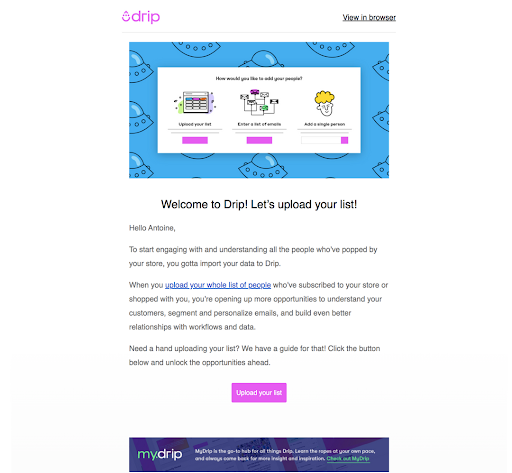
2. Promoting an offer
After attracting your visitors to join your email list, you can send them emails when you launch an offer in which they may be interested.
Visitors never want to miss out on any offer.
Below is an example of promoting an offer by Baby Registry.
After attracting your visitors to join your email list, you can send them emails when you launch an offer in which they may be interested.
Visitors never want to miss out on any offer.
Below is an example of promoting an offer by Baby Registry.
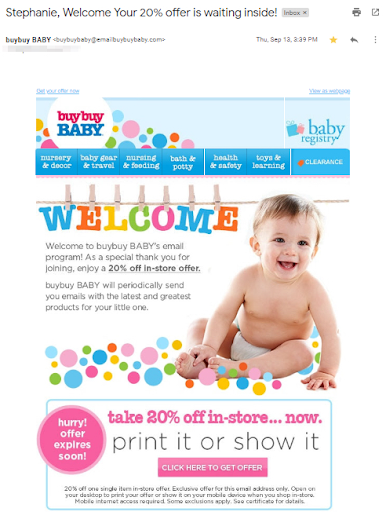
3. Limited offer campaign
One of the most used campaigns by hundreds of businesses is the limited offer drip campaign.
Emails like these work because they provide their customer with an offer they can't resist. The only option left for the customers is to avail of their product or service within the offer period before it gets late.
The best example of this type of campaign is LEESA.
One of the most used campaigns by hundreds of businesses is the limited offer drip campaign.
Emails like these work because they provide their customer with an offer they can't resist. The only option left for the customers is to avail of their product or service within the offer period before it gets late.
The best example of this type of campaign is LEESA.
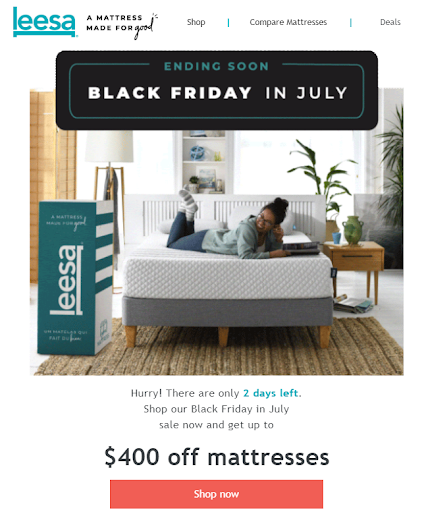
4. Unsubscribe Campaign
It would help if you had taken the hint when that one subscriber who always opens your email starts to ignore it.
No matter how tempting your offer can be, it will not satisfy the needs of some people. If you see your subscribers ignoring your email, you need one email campaign to fix your relationship with them.
Paul Mitchell's campaign is the best example for this situation.
It would help if you had taken the hint when that one subscriber who always opens your email starts to ignore it.
No matter how tempting your offer can be, it will not satisfy the needs of some people. If you see your subscribers ignoring your email, you need one email campaign to fix your relationship with them.
Paul Mitchell's campaign is the best example for this situation.
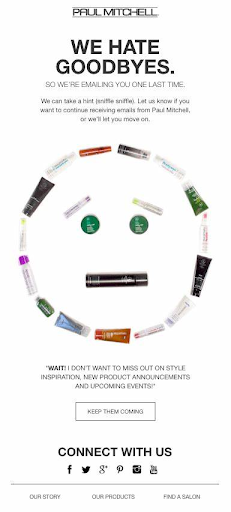
Read>> Get More Subscribers With Your Email Sign-up Form
5. Lead Nurturing
Not all visitors who visit your website turn into customers. Some of them need time to think. This is where the drip email campaign comes in.
Lead nurturing emails are built to develop a relationship with the subscribers and win their trust.
The 5TH offers VIP access to a 24-hour sale is an example of a lead nurturing drip email campaign.
5. Lead Nurturing
Not all visitors who visit your website turn into customers. Some of them need time to think. This is where the drip email campaign comes in.
Lead nurturing emails are built to develop a relationship with the subscribers and win their trust.
The 5TH offers VIP access to a 24-hour sale is an example of a lead nurturing drip email campaign.

Over to you…
While it's not hard to make a drip email campaign, it can additionally be difficult to make a fruitful drip email campaign. The issue is the thing that works for one company may not work for another, or even among two segmented records at the same company.
Whatever business you are running, a drip email campaign will prove to be helpful and save you time. So, follow the best practices and employ the right set of sales tools that enable you to create effective drip email campaigns.
Yet at last, it's dependent upon you to tinker with your strategy and execution to discover what works for you to achieve your objectives and lift your sales.
While it's not hard to make a drip email campaign, it can additionally be difficult to make a fruitful drip email campaign. The issue is the thing that works for one company may not work for another, or even among two segmented records at the same company.
Whatever business you are running, a drip email campaign will prove to be helpful and save you time. So, follow the best practices and employ the right set of sales tools that enable you to create effective drip email campaigns.
Yet at last, it's dependent upon you to tinker with your strategy and execution to discover what works for you to achieve your objectives and lift your sales.
Recent Posts
01 Jul 2025
Best Zoho CRM Integrations for Sales & Marketing in 2025
Discover the top Zoho CRM integrations in 2025 categorized by use case. Explore how each tool's key ...
01 Jul 2025
Sales Automation in 2025: The Guide to Close More Deals Faster
Struggling with manual sales workflows? Follow this guide to explore the sales automation use cases, ...
25 Jun 2025
Top 6 Email Finder APIs in 2025 for All Use Cases
Looking for a reliable Email Finder API? Explore the top 6 email finder APIs of 2025—compare key fea ...
17 Jun 2025
Top 10 Email Spam Checker Tools Tested & Reviewed (2025)
Check out the top 10 email spam checker tools to avoid junk folders. Compare features, ratings & use ...
06 Jun 2025
How To Create a Lead Magnet That Converts in 2025
Looking for more leads? Read how to create a high-converting lead magnet in 2025 with step-by-step g ...
Prospecting ,Email Finder & Email Verification Service
Prospecting ,Email Finder & Email Verification Service
Expand your reach by discovering and verifying the ideal prospects.
Sign up & get 100 free credits | No Credit Card required

